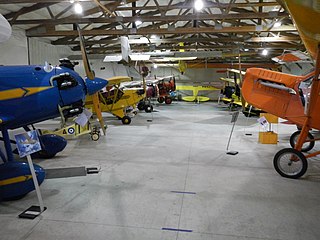
John Joseph Montgomery was an American inventor, physicist, engineer, and professor at Santa Clara University in Santa Clara, California, who is best known for his invention of controlled heavier-than-air flying machines.

Leslie Everett Baynes, AFRAeS was an English aeronautical engineer.
Abbott-Baynes Sailplanes Ltd. was a 1930s glider manufacturing company based at Wrecclesham, near Farnham, Surrey. It was founded as a subsidiary of E. D. Abbott Ltd in 1931 by L. E. Baynes and E. D. Abbott to build the Scud, a glider designed by Baynes in 1930, the prototype of which was built by Brant Aircraft Limited at Croydon Airport. The Scud was popular, and in 1932 a development of it, the Scud II model was launched. In 1935, a Scud II flown by Mungo Buxton took the British Height Record for a glider to 8,750 ft (2,666 m).

The National Soaring Museum (NSM) is an aviation museum whose stated aim is to preserve the history of motorless flight. It is located on top of Harris Hill near Elmira, New York, United States.

The Briegleb BG-12 is a single-seat sailplane of wooden construction developed in the United States in the 1950s. It was marketed for homebuilding in plans or kit form, with over 350 sets of plans selling by 1978. The BG-12 is a conventional sailplane design, with a high cantilever wing and a conventional empennage. Later models featured a highly revised fuselage, a swept-forward tail fin, and an all flying tailplane with balance tabs.

The Elliots Primary EoN or EoN Type 7 S.G.38 Primary was a training glider built in the UK shortly after World War II. It was an absolutely minimalist aircraft, consisting of a high, cable-braced wing connected to a conventional empennage by an open-truss framework, and was a copy of the German SG 38 Schulgleiter. Marketed to aeroclubs, the Primary EoN was also adopted in 1948 by the Air Training Corps and by the Combined Cadet Force under the name Eton TX.1. An example is at the Gliding Heritage Centre.

The Laister-Kauffmann TG-4 was a sailplane produced in the United States during the Second World War for training cargo glider pilots. It was a conventional sailplane design with a fuselage of steel tube construction and wooden wings and tail, covered all over with fabric. The pilot and instructor sat in tandem under a long canopy.

The Iowa Aviation Museum is located at the Greenfield Municipal Airport in Greenfield, Iowa, and is dedicated to preserving Iowa's aviation heritage. The Iowa Aviation Hall of Fame, located at the museum, honors Iowans who have contributed significantly to the growth of aviation.
The Explorer PG-1 Aqua Glider is an American single seat, biplane glider that was designed by Bill Skiliar in 1959 and made available as plans for amateur construction. The prototype was built with help from a troop of Air Explorer Scouts that same year.
This page is based on this
Wikipedia article Text is available under the
CC BY-SA 4.0 license; additional terms may apply.
Images, videos and audio are available under their respective licenses.






